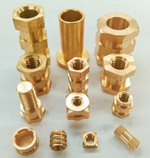Hi,
It's Pawan.
I'm designing a product containing many aluminium parts and lost in their mounting selection. I want to use thread-based mounting of components.
Now I've to mount one aluminium part with another using threads.
The problem is that the product will be in constant vibration of varying frequencies and all the components will experience tension which means if I use inserts there are chances of them getting pulled out.
I'm looking to strengthen the threads on aluminium as the weakest part of the product.
There are various components of aluminium and steel -
Also, I've seen a product that is a damper made of aluminium not sure of the specifics but the components were directly mounted by threads. The damper was a heavy truck damper.
Is it okay to directly mount the aluminium components by using threads?
I'd appreciate all the suggestions and answers. Also, I'm still learning and new to the industry so please help.
It's Pawan.
I'm designing a product containing many aluminium parts and lost in their mounting selection. I want to use thread-based mounting of components.
Now I've to mount one aluminium part with another using threads.
The problem is that the product will be in constant vibration of varying frequencies and all the components will experience tension which means if I use inserts there are chances of them getting pulled out.
I'm looking to strengthen the threads on aluminium as the weakest part of the product.
There are various components of aluminium and steel -
- Thread engagement length varies from part to part but the least is 10mm and the dia. is 30mm
- The material (specifically AL) is not finalized yet.
Also, I've seen a product that is a damper made of aluminium not sure of the specifics but the components were directly mounted by threads. The damper was a heavy truck damper.
Is it okay to directly mount the aluminium components by using threads?
I'd appreciate all the suggestions and answers. Also, I'm still learning and new to the industry so please help.


